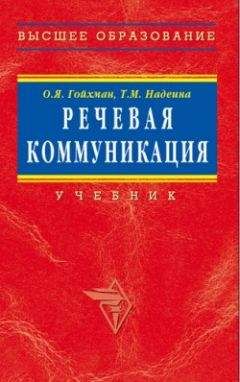Ричард Харрис - Психология массовых коммуникаций
Potter, W. J. (1991 b). The relationships between first-and second-order measures of cultivation. Human Communication Research, 18, 92–113.
Potter, W. J. (1993). Cultivation theory and research: A conceptual critique. Human Communication Research, 19,564–601.
Potter, W. J. (1998). Media literacy. Thousand Oaks, CA: Sage.
Powers, R. (1984). Supertube: The rise of television sports. New York: Coward-McCann.
Pratap, A. (1990, August 13). Romance and a little rape. Time, 69.
Pratkanis, A. R. (1992). The cargo-cult science of subliminal persuasion. Skeptical Inquirer, 16, 260–272.
Pratkanis, A. R., Aronson, E. (1992). Age of propaganda: The everyday use and abuse of persuasion. New York: W. H. Freeman.
Pratkanis, A. R., Greenwald, A. G. (1988). Recent perspectives on unconscious processing: Still no marketing applications. Psychology Marketing, 5, 339–355.
Preston, E. H. (1990). Pornography and the construction of gender. In: N. Signorielli M. Morgan (Eds.). Cultivation analysis (p. 107–122). Newbury Park, CA: Sage.
Preston, I. L. (1975). The great American blow-up: Puffery in advertising and selling. Madison: University of Wisconsin Press.
Preston, I. L. (1994). The tangled web they weave: Truth, falsity, advertisers. Madison: University of Wisconsin Press.
Preston, I. L., Richards, J. J. (1986). Consumer miscomprehension as a challenge to FTC prosecutions of deceptive advertising. The John Marshall Law Review, 19, 605–635.
Price, M. E. (Ed.). (1998). The V-chip debate: Content filtering from television to the Internet. Mahwah, NJ: Lawrence Eribaum Associates.
Price, V, Czilli, E. J. (1996). Modeling patterns of news recognition and recall. Journal of Communication, 46(2), 55–78.
Pritchard, D., Hughes, K. D. (1997). Patterns of deviance in crime news. Journal of Communication, 47(3), 49–67.
Protlas, J. M. (1983). Encouraging altruism: Public attitudes and the marketing of organ donation. Health and Society, 61(2), 278–306.
Provenzo, E. F, Jr. (1991). Video kinds: Making sense of Nintendo. Cambridge, MA: Harvard University Press.
Quinsey, V. L., Marshall, W. (1983). Procedures for reducing inappropriate sexual arousal: An evaluation review. In: J. G. Greer I. Stuart (Eds.). The sexual aggressor: Current perspectives on treatment. New York: Van Nostrand Reinhold.
Rabinovitch, M. S., McLean, M. S., Markham, J. W, Talbott, A. D. (1972). Children's violence perception as a function of television violence. In: G. A. Comstock, E. A.
Rubinstein, J. P. Murray (Eds.). Television and social behavior: Vol. 5. Television's effects: Further explorations. Washington, DC: U. S. Government Printing Office.
Rader, B. G. (1984). In its own image: How television has transformed sports. New York: The Free Press.
Rafaeli, S., LaRose, R. J. (1993). Electronic bulletin boards and "public goods" explanations of collaborative mass media. Communication Research, 20, 277–297.
Rainville, R., McCormick, E. (1977). Extent of covert racial prejudice in pro football announcers' speech. Journalism Quarterly, 54(1), 20–26.
Raju, P. S.. Lonial, S. C. (1990). Advertising to children: Findings and implications. Current Issues and Research in Advertising, 12, 231–274.
Ratzan, S. C., Payne, J. G., Massett, H. A. (1994). Effective health message design: The America Responds to AIDS campaign. American Behavioral Scientist, 38, 294–309.
Read, W. H. (1976). America's mass media merchants. Baltimore: The Johns Hopkins University Press.
Real, M. R. (1989). Super Bowl football versus World Cup soccer: A cultural-structural comparison. In: L. A. Wenner (Ed.). Media, spans, and society (p. 180–203). Newbury Park, CA: Sage.
Reeve, D. K., Agglcton, J. P. (1998). On the specificity of expert knowledge about a soap opera: An everyday story of farming folk. Applied Cognitive Psychology, 12, 35–42.
Reeves, B. (1989). Theories about news and theories about cognition: Arguments for a more radical separation. American Behavioral Scientist. 33, 191–197.
Reeves. В ., Nass, C. (1996). The media equation: How people treat computer, television, and the new media like real people and places. New York: Cambridge University Press.
Reeves, В ., Thorson, E., Rothschild, M., McDonald, D., Hirsch, J., Goldstcin, R. (1985). Attention to television: Intrastimulus effects of movement and scene changes on alpha variation over time. International Journal of Neuroscience. 25, 241–255.
Reid, R. T. (1979). Racial stereotyping on television: A comparison of the behavior of black and white television characters. Journal of Applied Psychology, 64(5), 465–489.
Report of the Special Committee on Pornography and Prostitution (Vol. I). (1985). Ottawa, ON, Canada: Minister of Supply and Services.
Rice, M. L, Huston, A.C., Truglio. R., Wright, J. C. (1990). Words from Sesame Street: Learning vocabulary skills while viewing. Developmental Psychology, 26, 421–428.
Rice, M. L., Huston. A. C., Wright, J. C. (1986). Replays as repetitions: Young children's interpretation of television forms. Journal of Applied Developmental Psychology, 7, 61–76.
Rich, F. (1997. December 26). Mental illness still needs a spokesman. Manhattan Mercury, p. A7.
Richards, J. I. (1990). Deceptive advertising. Hillsdale, NJ: Lawrence Eribaum Associates.
Riggs, M. (Director). (1992, June 15). Color adjustment. New York: Public Broadcasting Service.
Ritchie, D., Price, V. Roberts. D. F. (1987). Reading and television: A longitudinal investigation of the displacement hypothesis. Communication Research, 14, 292–315.
Roberts. D. R, Maccoby, N. (1985). Effects of mass communication. In: G. Lindzey E. Aronson (Eds.). Handbook of social psychology (3rd ed.). New York: Random House.
Robertson, T. S., Rossiter, J. R. (1974). Children and commercial persuasion: An attribution theory analysis. Journo/o/'Consumer/?escarc/;, /(!), 13–20.
Robertson, T. S., Ward. S., Gatignon, H., Klees, D. M. (1989). Advertising and children: A cross-cultural study. Communication Research. 16, 459–485.
Robinson, J. D. (1989). Mass media and the elderly: A uses and dependency interpretation. In: J. F. Nussbaum (Ed.). Life-span communication (p. 319–337). Hillsdale, NJ: Lawrence Eribaum Associates.
Robinson, J. P. (1990). Television's effects on families' uses of time. In: J. Bryant (Ed.). Television and the American family (p. 195–209). Hillsdale, NJ: Lawrence Eribaum Associates.
Robinson, J. R, Davis, D. K. (1990). Television news and the informed public: An information-processing approach. Journal of Communication, 40(3), 106–119.
Robinson, M. J., Shcehan, M. A, (1983). Over the wire and on TV: CBS and UPI in Campaign '80. New York: Sage.
Rogers, E. M., Dearing, J. W. (1988). Agenda-setting research: Where has it been, Where is it going? In J. A. Anderson (Ed.). Communication yearbook II (p. 555–594). Beverly Hills, CA: Sage.
Rogers, E. M., Dearing, J. W., Brcgman, D. (1993). The anatomy of agenda-setting research. Journal of Communication, 43(2), 68–84.
Rogers, E. M., Singhal, A. (1989). Estrategias de educacion entretenimiento [Strategics for educating through entertainment]. Chasqul, 31, 9–22.
Rogers, E. M., Singhal, A. (1990). The academic perspective. In: C. Atkin L. Wallack (Eds.). Mass communication and public health (p. 176–181). New-bury Park, CA: Sage.
Rojahn, K., Pettigrew, T. F. (1992). Memory for schema-relevant information: A meta-analytic resolution. British Journal of Social Psychology, 31, 81–109.
Rolandelli, D. R., Wright, J. C., Huston. A. C., Eakins, D. (1991). Children's auditory and visual processing of narrated and nonnarrated television programming. Journal of Experimental Child Psychology, 51, 90–122.
Romer, S. Jamieson, K. H., deCoteau, N. (1998). The treatment of persons of color in local television news. Communication Research, 25. 286–305.
Rosenberg, H. (1993, June II). TV gratuitously puts down another people. Manhattan Mercury, В 12.
Rosencrans, M. A., Hartup, W. W. (1967). Imitative influences of consistent and inconsistent response consequences to a model on aggressive behavior in children. Journal of Personality and Social Psychology, 7, 429–434.
Rosengren, K. E. (1992). The structural invariance of change: Comparative studies of media use (some results from a Swedish research program). In: J. G. Blumler, J. M. McLeod, К . Е . Rosengren (Eds.). Comparatively speaking: Communication and culture across space and time (p. 140–178). Newbury Park, CA: Sage.
Rosengren, K. E., Wenner, L. A., Palmgreen, P. (Eds.). (1985). Media gratifications research: Current perspectives. Newbury Park, CA: Sage.
Ross, J. (1992, August). The cola war's new front. World Press Review, p. 45.
Rotfeld, H. J. (1988). Fear appeals and persuasion: Assumptions and errors in advertising research. Curren/ fcsues one?/?esearc/!/n Adcerft's/ng. 11, 21–40.
Rothenberg, D. (1998, June 5). The sounds of global change: Different beats, new ideas. The Chronicle of Higher Education, p. B8.
Rothenbuhler, E. W. (1988). The living room celebration of the Olympic games…/owna/ of Communication, 38(4), 61–81.
Roy, A., Harwood, J. (1997). Underrcpresented, positively portrayed: Older adults in television commercials. Journal of Applied Communication Research, 25, 39–56.
Rubin, A. M. (1981). An examination of television viewing motivations. Communication Research, 8, 141–165.
Rubin, A. M. (1983). Television uses and gratifications: The interactions of viewing patterns and motivations. Journal of Broadcasting, 27, 37–51.
Rubin, A. M. (1984). Ritualized and instrumental television viewing. Journal of Communication, 34(3), 67–77.
Rubin, A. M. (1986). Uses, gratifications, and media effects research. In: J. Bryant D. Zillmann (Eds.). Perspectives on media effects (p. 281–301). Hillsdale, NJ: Lawrence Eribaum Associates.
Rubin, A. M. (1994). Media uses and effects: A uses-and-gratifications perspective. In: J. Bryant D. Zillmann (Eds.). Media effects: Advances in theory and research (p. 417–437). Hillsdale. NJ: Lawrence Eribaum Associates.
Rubin, A. M., Perse, E. M. (1987). Audience activity and television news gratifications. Communication Research, 14, 58–84.
Rubin, A. M., Perse, E. M. (1988). Audience activity and soap opera involvement. Human Communication Research, 14, 246–268.
Rubin, A. M., Perse, E. M., Powell, R. A. (1985). Loneliness, parasocial interaction, and local television news viewing. Human Communication Research, 12, 155–180.
Rubin, A. M., Perse. E. M., Taylor, D. S. (1988). A methodological examination of cultivation. Commun-fcorion/?eseorcn, /5, 107–134.
Rubin, A. M., Wmdahl, S. (1986). The uses and dependency model of mass communication. Critical Studies in Mass Communication, 3, 184–199.
Rubin, D. M., Cummings, C. (1989). Nuclear war and its consequences on television. Journal of Communication, 39(1), 39–58.
Rubin, R. В ., McHugh, M. P. (1987). Development of parasocial interaction relationships. Journal of Broadcasting Electronic Media. 31, 279–292.
Rumelhart, D. E. (1980). Schemata: Building blocks of cognition. In: R. J. Spiro, B. C. Bruce. W. F. Brewer (Eds.). Theoretical issues in reading comprehension (p. 33–58). Hillsdale, NJ: Lawrence Eribaum Associates.




